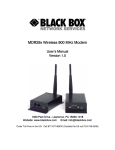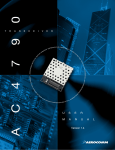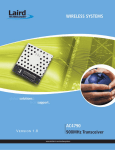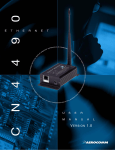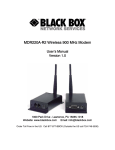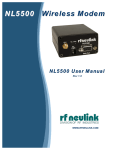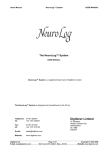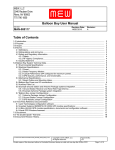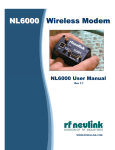Download Raveon NL900PRO User manual
Transcript
NL900PRO User Manual Version B0 Radio Data Modem With Selectable RS232 RS485 RS422 7610 MIRAMAR ROAD San Diego, CA 92126 (800) 233-1728 www.rfneulink.com [email protected] DOCUMENT INFORMATION Copyright © 2013 Raveon Technologies The information contained in this manual and the accompanying software programs are copyrighted and all rights are reserved by Raveon Technologies Corporation. Raveon reserves the right to make periodic modifications of this product without obligation to notify any person or entity of such revision. Copying, duplicating, selling, or otherwise distributing any part of this product or accompanying documentation/software without the prior consent of an authorized representative of Raveon is strictly prohibited. All brands and product names in this publication are registered trademarks or trademarks of their respective holders. This material is preliminary Information furnished by Raveon Technologies in this specification is believed to be accurate. Devices sold by Raveon Technologies are covered by the warranty and patent indemnification provisions appearing in its Terms of Sale only. Raveon Technologies makes no warranty, express, statutory, and implied or by description, regarding the information set forth herein. Raveon Technologies reserves the right to change specifications at any time and without notice. Raveon Technologies’ products are intended for use in normal commercial and industrial applications. Applications requiring unusual environmental requirements such as military, medical life-support or life-sustaining equipment are specifically not recommended without additional testing for such application. Limited Warranty, Disclaimer, Limitation of Liability For a period of one (1) year from the date of purchase by the OEM customer, Raveon Technologies warrants the OEM transceiver against defects in materials and workmanship. Raveon Technologies will not honor this warranty (and this warranty will be automatically void) if there has been any (1) tampering, signs of tampering; 2) repair or attempt to repair by anyone other than an Raveon Technologies authorized technician. This warranty does not cover and Raveon Technologies will not be liable for, any damage or failure caused by misuse, abuse, acts of God, accidents, electrical irregularity, or other causes beyond Raveon Technologies’ control, or claim by other than the original purchaser. In no event shall Raveon Technologies be responsible or liable for any damages arising: From the use of product; From the loss of use, revenue or profit of the product; or As a result of any event, circumstance, action, or abuse beyond the control of Raveon Technologies, whether such damages be direct, indirect, consequential, special or otherwise and whether such damages are incurred by the person to whom this warranty extends or third party. If, after inspection, Raveon Technologies determines that there is a defect, Raveon Technologies will repair or replace the OEM transceiver at their discretion. If the product is replaced, it may be a new or refurbished product. 1 NL900PRO RF TRANSCEIVER 1 The NL900PRO transceiver is a Frequency-Hopping Spread Spectrum (FHSS) radio designed for license-free operation in the 900 MHz ISM band. The radio sustains a standard asynchronous serial data stream between two or more radios out of the box. Housed in a compact and rugged die-cast enclosure, the radio is equipped to replace miles of serial cable using a selectable RS232, RS485, or RS422 interface. NL900PRO FEATURES NETWORKING AND SECURITY • Retries and Acknowledgements • API Commands to control packet routing and acknowledgement on a packet-by-packet basis • Frequency Hopping Spread Spectrum for security and interference rejection • Customizable RF Channel number and system ID • Dynamic link analysis, remote radio discovery • Low latency and high throughput EASY TO USE • Continuous 76.8 kbps RF data stream • Software selectable interface baud rates from 1200 bps to 115.2 kbps • Advanced configuration available using AT commands OVERVIEW The NL900PRO uses Frequency Hopping Spread Spectrum modulation, where the units "hop" from frequency to frequency many times per second using a specific hop pattern applied to all the transceivers in the same network. A distinct hopping pattern is provided for each Channel Number, thereby allowing multiple networks to co-exist in the same area without interference. NL900PRO transceivers operate in a Point-to-Point or Point-to-Multipoint, Client-Server architecture. One transceiver is configured as a Server and there can be one or many Clients. To establish communication between transceivers, the Server emits a beacon and upon detecting a beacon, RF link is established with the Client(s). NL900PRO implement a proprietary communication protocol to provide secure data transmissions. The use of FHSS technology ensures data reliability over long distances. Use of license free frequency bands ensure that the units are ready for use with no further certification requirements. Each unit is small and easily portable for use in mobile and temporary settings as well as for fixed installations. The NL900PRO configuration software enables custom configurations based on unique application requirements. C H A P T E R 1 - NL900P R O R F T R A N S C E I V E R This document contains information about the hardware and software interface between an Raveon Technologies NL900PRO transceiver and an OEM Host. Information includes the theory of operation, specifications, interface definition, configuration information and mechanical drawings. The OEM is responsible for ensuring the final product meets all appropriate regulatory agency requirements listed herein before selling any product. Note: NL900PRO modules will be referred to as the “radio” or “transceiver”. Individual naming is used to differentiate product specific features. The host (PC, Microcontroller, or any device to which the NL900PRO is connected) will be referred to as “OEM Host”. 3 2 SPECIFICATIONS 2 TABLE1: NL900PRO SPECIFICATIONS INTE RFACE Serial Interface Connector DB-9 Female RF Connector RPSMA Jack Impedance 50 ohms unbalanced Serial Interface Data Rate Baud rates from 1200 bps to 115,200 bps Power Consumption (typical) 400 mA @ 12VDC Channels 52 (USA); 7 (Australia) Supported Network Topologies Point-to-Point, Point-to-Multipoint Security One byte System ID. 56-bit DES encryption key. Interface Buffer Size Input/Output: 1600 bytes each OPERATIO NAL Frequency Band 902 – 928 MHz (USA); 915-928 MHz (Australia) RF Data Rate 76.8 kbps fixed RF Technology Frequency Hopping Spread Spectrum Output Power NL900PRO: Conducted (no antenna) 743mW typical Supply Voltage NL900PRO: 7-28VDC Sensitivity -100dBm typical @ 76.8kbps RF Data Rate Range, Line of Site (based on 3dBi gain antenna) NL900PRO: Up to 20 miles ENVIRO NME NTAL Temperature (Operating) -40°C to 80°C Temperature (Storage) -50°C to +85°C PHYSICAL Dimensions 4.4 x 2.7 x 1.4 inches Weight 6 oz (170 g) CERTIFICATIONS FCC Part 15.247 NL900PRO: KQLAC4490 Industry Canada (IC) NL900PRO: 2268C-AC44901000 EIRP (3dBi gain antenna) 1486mW typical 3 SERIAL INTERF ACE 3 The NL900PRO supports RS232, RS485, and RS422 protocols. Raveon Technologies wireless solutions are not subject to the cabling restrictions for distance, and either interface is available when ordering. F i g u r e 1: N L 9 0 0 P R O S t a t u s L E D s Status LEDs DIP Switch RPSMA Antenna Connector ON 1 2 Pwr Link Rx 3 4 5 6 Tx TABLE 2: STATUS LEDS LED COLOR DESCRIPTION Pwr Green On indicates that the unit is powered up. Link Red On indicates that the Client unit(s) and Server unit are in range of each other. Client units activate the Link LED when in Range of the Server unit. Always lit on a Server unit. RXD Green When flashing, indicates that the NL900PRO is receiving data. TXD Red When flashing, indicates that the NL900PRO is transmitting data. F i g u r e 2 : N L 9 0 0 P R O D I P S w i t ch S e t t i n g s ON 1 2 3 4 5 6 Serial Interface 1 2 RS232 RS232 Forced 9600 2 wire RS485 4 wire RS485/422 TX/RX Mode 5 6 RS485/422 Termination 3 4 None Client, Addressed Client, Broadcast 2 wire RS485 termination Server, Addressed 4 wire RS485/ 422 termination Server, Broadcast CHA PTER 3 - SERIAL INTE RFACE RS232 RS232 is a single-ended data transmission protocol. The RS232 signals are represented by voltage levels with respect to a system common (power/logic ground). The “idle” state (MARK) has the signal level negative with respect to common, and the “active” state (SPACE) has the signal level positive with respect to common. Figure 3: RS232 DIP Switch Settings ON 1 ON 2 3 4 5 6 1 Normal RS232 Operation 2 3 4 5 6 Forced 9600 Mode TABLE 3: NL900PRO RS232 PINOUT 9 6 5 DB9 PIN SIGNAL NAME I/O DES CRIP TIO N DETAILS 1 DCD O Data Carrier Detect Carrier Detect Signal. Connects to DSR (pin 6). 2 TXD O Transmitted Data Serial Data from modem to Host. 3 RXD I Received Data Serial Data from Host to Modem. 4 DTR I Data Terminal Ready Used to determine if modem is ready for operation. 5 GND - Ground Ground 6 DSR O Data Set Ready Connects to DCD (pin 1). 7 RTS I Request To Send Provides RTS Flow Control 8 CTS 0 Clear To Send Provides CTS Flow Control 9 NC - No Connect No Connect 1 Female DB9 5 CHA PTER 3 - SERIAL INTE RFACE RS485 (2-WIRE) The RS-485 interface uses a Differential Data Transmission that can help nullify the effects of ground shifts and induced noise signals that can appear as common mode voltages on a network. The NL900PRO implements a RS-485 (2-wire Half Duplex) multi-drop interface. Typically, a RS-485 bus will consist of a master and several slaves. The nodes will have unique addresses and can send addressed packets to specific nodes. Because the bus is half duplex, no two nodes should try to talk at the same time. The NL900PRO does not have a RS-485 address, therefore, it will transmit all RS-485 traffic over the RF. Conversely, as soon as a NL900PRO receives a packet over the RF, it will transmit the packet over the RS485 bus. F i g u r e 4 : R S 4 8 5 H a l f D u p l e x w i t h Termination D I P S w i t ch S et tings ON 1 ON 2 3 4 5 6 With Termination 1 1 2 3 4 5 6 Without Termination 1. Termination is a 120 ohm resistor between TR- and TR+. TABLE 4: NL900PRO RS485 PINOUT 9 6 5 1 Female DB9 DB9 PIN SIGNAL NAME DESCRIPTION 1 - No Connect 2 TR- Serial Data transmitted to & received from radio 3 - No Connect 4 - No Connect 5 GND Ground 6 - No Connect 7 - No Connect 8 TR+ Serial Data transmitted to & received from radio 9 Power Optional Power Input1 1. An internal jumper must be configured in order to use power over Pin 9. 6 CHA PTER 3 - SERIAL INTE RFACE RS485 (4-WIRE) AND RS422 Figure5: RS4 85 Full Duplexwith T e r m i n at i o n D I P S w i t ch S e t t i n g s ON 1 ON 2 3 4 5 6 With Termination 1 1 2 3 4 5 6 Without Termination 1. Termination is a 120 ohm resistor. TABLE 5: NL900 PRO RS422 PINOUT 9 6 5 DB9 PIN SIGNAL NAME DESCRIPTION 1 - No Connect 2 T- Serial Data transmitted to radio 3 R- Serial Data received by radio 4 - No Connect 5 GND Ground 6 - No Connect 7 R+ Serial Data received by radio 8 T+ Serial Data transmitted to radio 9 Power Optional Power Input1 1 Female DB9 1. An internal jumper must be configured in order to use power over Pin 9. HARDWARE FLOW CONTROL Flow control refers to the control of data flow between the host and the NL900-PRO. It is the method used to handle data in the transmit/receive buffer of the NL900-PRO interface, and determines how data flow between the host and the NL900-PRO is throttled. Often in serial communication, one device is capable of sending data much faster than the other can receive. Flow control allows the slower device to tell the faster device to pause and resume data transmission. (Flow control CTS and RTS are used by the NL900-PRO and its Host, locally - NOT over the air. Therefore, one NL900-PRO cannot tell the other to slow down or speed up as is mentioned above in the paragraph). When the RTS Enable option is selected on the Configuration Utility, the transceivers use hardware flow control to regulate data flow. While using hardware flow control, the transceiver that is ready to receive data sends a Clear To Send signal to its host (or the device it is connected to). On the other hand, when a transceiver has something it wants to send to its host, it checks the state of Ready To Send and if it is logic low, will send data to its host. If RTS is logic high, it will not send data to its host. These signals are sent apart from the data itself on separate wires. 7 CHA PTER 3 - SERIAL INTE RFACE Note: CTS is always enabled by default. RS-485 Interface does not support Hardware flow control. DESIGN TIP Can I implement a design using just Txd, Rxd and Gnd (Three-wire Interface)? Yes. However, it is strongly recommended that your hardware monitor the CTS pin of the radio. CTS is taken High by the radio when its interface buffer is getting full. Your hardware should stop sending at this point to avoid a buffer overrun (and subsequent loss of data). You can perform a successful design without monitoring CTS. However, you need to take into account the amount of latency the radio adds to the system, any additional latency caused by Transmit Retries or Broadcast Attempts, how often you send data, non-delivery network timeouts and interface data rate. Polled type networks, where the Server host requests data from the Client host and the Client host responds, are good candidates for avoiding the use of CTS. This is because no one transceiver can monopolize the RF link. Asynchronous type networks, where any radio can send to another radio at any point in time, are much more difficult to implement without the use of CTS. 8 4 THEORY OF OPER ATI ON 4 RF ARCHITECTURE The NL900PRO utilizes a Server-Client network where all Clients synchronize their hopping to the Server. The Server transmits a beacon during the first 1 ms of every hop (20 ms). The Client transceivers listen for this beacon and upon hearing it assert their In Range Low and synchronize their hopping with the Server. Each network should consist of only one Server and there should never be two servers on the same RF Channel number in the same coverage area as the interference between the two servers will severely hinder RF communications. For those applications requiring collocated servers, Raveon Technologies recommends using the Sync-to-Channel feature which is further explained in the Sync-to-Channel Appendix. MODES OF OPERATION The NL900PRO has three different operating modes; Receive, Transmit, & Command Mode. If the transceiver is not communicating with another radio, it will be in Receive Mode actively listening for a beacon from the Server. If the Client determines that the beacon is from a server operating on the same RF Channel and System ID, it will respond by asserting In Range Low. A transceiver will enter Transmit or Command mode when the OEM Host sends data over the serial interface. TRANSMIT MODE All packets sent over the RF are either Addressed or Broadcast packets. Broadcast and Addressed delivery can be controlled dynamically with the API Control byte and corresponding on-the-fly commands. To prohibit transceivers from receiving broadcast packets, Unicast only can be enabled. ADDRESSED PACKETS When sending an addressed packet, the RF packet is sent only to the receiver specified in destination address. To increase the odds of successful delivery, Transmit retries are utilized. Transparent to the OEM Host; the sending radio will send the RF packet to the intended receiver. If the receiver receives the packet free of errors, it will return an RF acknowledge within the same 20 ms hop. If a receive acknowledgement is not received, the radio will use a transmit retry to resend the packet. The radio will continue sending the packet until either (1) an acknowledgement is received or (2) all transmit retries have been used. The received packet will only be sent to the OEM Host if and when it is received free of errors. BROADCAST PACKETS When sending a broadcast packet, the RF packet is sent out to every eligible transceiver on the network. To increase the odds of successful delivery, Broadcast attempts are utilized. Transparent to the OEM Host, the sending radio will send the RF packet to the intended receiver(s). Unlike transmit retries, all broadcast attempts are used; regardless of when the RF packet is actually received and without RF acknowledgements. If the packet is received on the first attempt, the receiver will ignore the remaining broadcast attempts. The received packet will only be sent to the OEM Host if and when it is received free of errors. 10 CHAPTER 4 - THEORY OF OPERATION RECEIVE MODE When a transceiver is not in Transmit or Command mode, it will be in Receive Mode listening for data. While in Receive Mode, subsequent data of up to 80 bytes can be received every hop (20 ms). COMMAND MODE A radio will enter Command Mode when data is received over the serial interface from the OEM Host and contains the “AT+++” (Enter AT Command Mode) command. Once in Command Mode, all data received by the radio is interpreted as command data. Command Data can be either EEPROM Configuration or On-TheFly commands. FIGURE 6: PENDING RF AND DATA IN BUFFER FLOW Yes Discard Packet Receive full packet and check CRC Receive Mode Receive Mode Pending RF Received Data in Buffer Broadcast Packet Discard Packet Command/Data Mode YES AT+++ RF Data Addressed Packet Yes Yes Matching Destination MAC Duplicate Packet Broadcast Packet Addressed Packet Transmit Packet Transmit Packet Decrement Broadcast Attempts Receive ACK Broadcast Attempts = 0 Decrement Transmit Attempts Yes Send Packet over RF Validate CRC Yes Duplicate Packet Send Packet over RF Yes Send RF Acknowledge YES Transmit Attempts = 0 YES YES 11 CHAPTER 4 - THEORY OF OPERATION NETWORK TOPOLOGIES Topology refers to the shape of a network, or the network's layout. How different nodes in a network are connected to each other and how they communicate, is determined by the network's topology. The NL900PRO supports a Point-to-Point and a Point-to-Multipoint network topology. POINT-TO-POINT A point-to-point network consists of a single Server and Client pair. Sometimes referred to as a wireless bridge, a point-to-point link replaces a single communications cable. OEM Host OEM Host Server Client POINT-TO-MULTIPOINT Point-to-Multipoint systems have one base station, or access point, that controls communications with all of the other wireless nodes in the network. This allows for the creation of a wireless network consisting of multiple nodes. By programming each NL900PRO with a network specific Channel Number and System ID multiple networks can be created. Client Client Client Client Client Client Client Server Client Server Client Channel: 0x10 System ID: 0x01 Client Client Client Channel: 0x15 System ID: 0x05 5 NL900PRO SETTINGS 5 SETTINGS 1) Client/Server: Designates NL900PRO type. In each network, there must be only one Server. All other NL900PRO units must be programmed as Clients. The number of Clients in the network is not limited; however, if performance diminishes, consider additional RF Networks. 2) Interface Baud Rate: This defines the baud rate used for communicating with the NL900PRO over the serial interface. The RF baud rate is fixed at 76.8 Kbps and is independent of the Interface Baud Rate. The default baud rate setting is 57600 bps unless the units have been pre-configured by Raveon Technologies. The Interface Baud Rate setting of the NL900PRO must match the Baud Rate setting of its host device. 3) Channel Number: A number that designates an independent network of NL900 units. Up to 32 independent networks can be created. The valid range of values for this field is 16 to 47. 4) Max Transmit Retries (For Clients and Servers in Point-to-Point networks only): This value represents the maximum number of times a particular data packet will be transmitted unsuccessfully, or without an acknowledgement, before the NL900PRO discards the packet. The default value is 16 attempts. If communication is lost and the Client's Link LED is on, try increasing this value in small increments until communication is reestablished. Note: This value is always associated to Client radios and Server radios in Point to Point Mode. The valid range of values for this field is 1 to 255. 5) Broadcast Attempts (For Servers in Point-to-Multipoint networks only): This value represents the number of times a data packet will be transmitted by the Server NL900PRO. The default value is 4 attempts. If communication is lost and the Clients' Link LED is on, try increasing this value in small increments until communication is reestablished. The valid range of values for this field is 1 to 255. 6) System Identification: A number from 0 to 256 that provides added security to each independent network of NL900PRO units. The System ID is used in conjunction with the Channel Number and serves as an RF password to maintain secure transfers of data. The combination of the Channel Number and System ID must be unique to each network of NL900PRO to establish communication. Multiple Servers in the same coverage area must be programmed with different Channel Numbers to prevent inoperability of the networks. The System ID will not prevent inoperability that occurs from locating multiple Servers with the same Channel Number in the same coverage area. Note: Separate Collocated NL900PRO networks must operate on different Channel Numbers. All units in a given NL900PRO network must have identical Channel Numbers and System IDs. 7) Data Encryption Key: Encryption is the process of encoding an information bit stream to secure the data content. The DES algorithm is a common, simple and well-established encryption routine. An encryption key of 56 bits is used to encrypt the packet. The receiver must use the exact same key to decrypt the packet; otherwise garbled data will be produced. 8) Destination Address: The MAC Address of the remote NL900PRO in a Point-to-Point network. Used to optimize Point-to-Point communications by utilizing RF Acknowledgement. 9) Firmware Version: Displays the NL900PRO's firmware version. CHA PTER 5 - NL 900PRO SE TTI NGS 12 10) MAC Address: A unique 6 Byte, IEEE 802.3 Ethernet address assigned by Raveon Technologies to each NL900PRO. RADIO FEATURES 1) Data Encryption: Enables the Data Encryption Key. All NL900s in the same network must have the same encryption setting. 2) RTS Enable: Enables the Request To Send control line. When enabled, enables Hardware Flow Control. 3) Parity: Needs to be enabled if host requires even or odd parity and 8 data bits. This is considered as 9-bit mode. Note: Enabling Parity cuts the overall throughput into half. 4) Full Duplex: This mode restricts Client radios to transmitting on odd numbered frequency hop bins and the Server to even numbered frequency hop bins. Though the RF hardware is still technically half duplex, it makes the transceiver seem full duplex. This can cause overall throughputs to be cut in half. Note: All transceivers on the same network must have the same setting for Full Duplex. 5) Modem Mode: Full modem handshaking is supported by the transceivers when Modem Mode is enabled. Modem Mode is incompatible with RS-485Interface. Enables, DCD, DTR, DSR and Ring Indicator control lines. PROGRAMMING THE NL900PRO RADIO 1 Connect a NL900PRO unit to the serial communications port on the PC. 2 Connect the power supply to the NL900PRO unit. Make sure the Pwr LED is on. 3 Start the Raveon Technologies Configuration Utility. 4 Select the COM Port that is connected to the NL900PRO unit on the PC Settings page. 5 Select the Interface Baud Rate of the NL900PRO unit. All NL900PRO units are shipped with a default rate of 57600 (unless units have been pre-configured to match specific serial settings). If the Interface Baud Rate of the NL900PRO unit is changed, the PC Setting Baud Rate must be set to the same Baud Rate to allow proper programming of the units. 6 Select Read Radio to display the current settings of the NL900PRO unit. 7 Change desired settings. 8 After all changes have been made, select Write Radio to save the changes. 9 Cycle Power to the unit after all changes has been saved. This will set the NL900PRO unit to its normal mode of operation. CHA PTER 5 - NL 900PRO SE TTI NGS Note: The Show Defaults button can be used to display the default Radio settings. DESIGN TIP The Raveon Technologies Configuration utility automatically programs the mode (point-to-point or point- to-multipoint) based on the radio’s current settings: If the Destination Address field is set to any value other than FF FF FF FF FF FF, the radio will send data only to the radio whose MAC matches that specified in the Destination Address field (point-to-point). 1 2 3 If the Destination Address field is set to FF FF FF FF FF FF on a client radio, it will be set to auto destination mode & transmit to the radio whom it last received a packet from. If the Destination Address field is set to FF FF FF FF FF FF on a server radio, it will be set to Broadcast mode & transmit to all available clients (point-to-multipoint). 14 6 MECHANICAL 7 Figure 7: NL900PRO Mechanical 1.170 Ante SMA 0.536 0.060 0.000 Side View Label Recess, 3.5w x 2.0h 0.15 (4) p 2.750 2.375 2.0 D-Connector Status 0 dia. pin and g, pin is PWR. 0.375 0.000 Top View Limited One Year Warranty If within one years from date of purchase, this product fails due to a defect in material or workmanship, Raveon Technologies, Incorporated will repair or replace it, at Raveon’s sole discretion. This warranty is extended to the original consumer purchaser only and is not transferable. This warranty does not apply to: (a) product damage caused by accident, dropping or abuse in handling, acts of God or any negligent use; (b) units which have been subject to unauthorized repair, opened, taken apart or otherwise modified; (c) units not used in accordance with instructions; (d) damages exceeding the cost of the product; (e) batteries; (f) the finish on any portion of the product, such as surface and/or weathering, as this is considered normal wear and tear; (g) transit damage, initial installation costs, removal costs, or reinstallation costs; (h) damage due to lighting, floods, water intrusion, condensing humidity, fire, or earthquakes. RAVEON TECHNOLOGIES INCORPORATED WILL NOT BE LIABLE FOR INCIDENTAL OR CONSEQUENTIAL DAMAGES. SOME STATES DO NOT ALLOW THE EXCLUSION OR LIMITATION OF INCIDENTAL OR CONSEQUENTIAL DAMAGES, SO THE ABOVE LIMITATION OR EXCLUSION MAY NOT APPLY TO YOU. THIS WARRANTY IS IN LIEU OF ALL OTHER EXPRESS OR IMPLIED WARRANTIES. ALL IMPLIED WARRANTIES, INCLUDING THE WARRANTY OF MERCHANTABILITY AND THE WARRANTY OF FITNESS FOR A PARTICULAR PURPOSE, ARE HEREBY MODIFIED TO EXIST ONLY AS CONTAINED IN THIS LIMITED WARRANTY, AND SHALL BE OF THE SAME DURATION AS THE WARRANTY PERIOD STATED ABOVE. SOME STATES DO NOT ALLOW LIMITATIONS ON THE DURATION OF AN IMPLIED WARRANTY, SO THE ABOVE LIMITATION MAY NOT APPLY TO YOU. This warranty gives you specific legal rights and you may also have other rights which vary from state to state. Warranty service is available by mailing postage prepaid to: Raveon Technologies Corporation 2461 Impala Drive Carlsbad, CA 92010 - USA To obtain warranty service, include a copy of the original sales receipt or invoice showing the date, location, and price of purchase include a written description of the problem with the product, a phone number and name of person who may be contacted regarding the problem, and the address to where the product should be returned. Products repaired under warranty will typically have their program memories erased and reset to factory default settings.



















